Charles Coppock, 1837 – 1900
by Brian Stevenson
last updated December, 2017
Although his name is now largely forgotten, Charles Coppock was
a significant person in mid- to late-1800s English microscopy. He was part owner of the R. and J. Beck microscope firm, along with Joseph Beck and Robert Kemp (R. Beck died in 1866, shortly after the company was formed). Coppock left Beck to start his own microscope firm in 1882, selling instruments of his own manufacture, as well as being the English agent for Nachet, Zeiss, Tolles, Bulloch, Spencer and other makers. Coppock’s firm also sold microscopy supplies and slides.
Microscopical
Mounts and Mounters briefly describes Coppock’s slides as “various subjects, probably factored.” That conclusion is undoubtedly
correct. As the owner of a large
microscope production and retail enterprise, Coppock was unlikely to have spent
his time producing such mundane objects as microscope slides. As with Andrew Pritchard, the Smith-Beck consortia, Watson and Sons and
other such microscope makers/sellers, Charles Coppock would have sold slides
made by other people, under his own label. The slides shown in Figures 1 and 2 bear striking resemblances to slides labeled as coming from Moritz Hensoldt, of Wetzlar, Germany, and by Moritz’s son, Heinrich Hensoldt, who lived in London during the early 1800s. It is not remarkable that the labels mention only Coppock. His former business, R. and J. Beck, and its predecessors also struck identification of their makers from slides which they sold.
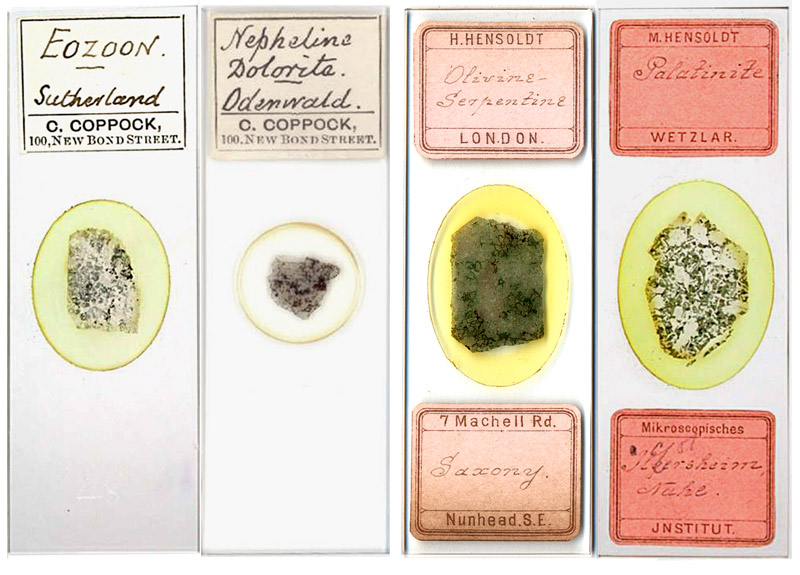
Figure 1.
Slides of thin-sectioned rock specimens
sold by Charles Coppock, alongside two similar slides, one labeled Heinrich Hensoldt and the other his father, Moritz. Slides of Eozoon from Sutherland and nepheline dolorite from Odenwald were produced by Heinrich Hensoldt for the 1884 “Studies in Micrographic Petrography”, a partnership between Hensoldt and J. Ernest Ady. Coppock exhibited a slide of “Eozoon canadense from Sutherlandshire” at the 13 June, 1883 meeting of the Royal Microscopical Society, and donated that slide, plus three of Bacillus (now Mycobacterium) tuberculosis in human lung and one of Bacillus anthracis in cow lung, to the Society. This occurred approximately 6 months after Coppock formed his independent microscopy business. Since he was selling slides of sectioned eozoons and bacteria such as M. tuberculosis at that time (see below and Fig. 6), this would have been excellent advertising for his new business.

Figure 2. A slide of arranged,
transversely-sectioned echinus spines sold by Charles Coppock, alongside a very
similar slide labeled M. Hensoldt (probably made by his son, H. Hensoldt). Note that the two slides have identical ringing colors and pattern.
.

Figure 3. Slides of Bangia atropurpurea (a marine
alga) and a stained, vertical section of a Rosa canina (dog rose) stem,
including a thorn. Heinrich Hensoldt’s partner, J.E. Ady, was also partnered with slide-maker Alfred J. Doherty. Doherty is known to have supplied Ady with microscope slides of Rosa canina sections, so the rose stem slide may be a Doherty production.
Charles Coppock was born in early 1837, being christened on 23
March at Saint Martin in the Fields, London. His father, also named Charles, was a customs inspector,
originally from Stockport, Cheshire. His mother, Kazia, was from Kent. When young Charles was about 1 year old, his aunt, Charlotte Coppock,
was married in Stockport to the Reverend William Smith, the great investigator
of diatoms. Charles evidently
enjoyed a close relationship with his uncle and aunt, and was staying with them
in Southover, Sussex at the time of the 1851 census. Coppock later helped his uncle in preparing microscope slides of diatoms. William Carruthers wrote in 1862 that “as Smith had found it profitable to sell slides he had set his nephew to work to mount for him” (Wise, 1958).
Charles entered Queen's College, Cork, reportedly with the
original intention of becoming a Civil Engineer. He graduated in 1856, and
shortly thereafter began working for the Smith, Beck and Beck microscope
firm. It has been suggested that Coppock’s job Smith, Beck and Beck may have helped his Uncle William Smith to sell slides through that company (Nuttall, 2009). However, since William died in 1857, any assistance Coppock could have provided would have been brief. More likely, since William Smith already had a long-standing
relationship with the microscope makers, he probably helped Charles acquire
his job.
The 24 year-old
optician was listed in the 1861 census as being a boarder at 6 Coleman St.,
Middlesex, which was then the address of the Smith, Beck and Beck business. He was the sole boarder, and lived with a 53 year-old housekeeper. The on-site living arrangement suggests that Coppock already had an important position with the company. On 20 April, 1864, Charles Coppock was elected to be a Member of the British (later Royal) Meteorological Society. He was later elected to be a Fellow of the Royal Microscopical Society (R.M.S., in 1867) and a Fellow of the Royal Astronomical Society (R.A.S., in 1871). According to the June, 1864, list of members of the British Meteorological Society, Coppock then resided at 31 Cornhill. The business of Smith, Beck and Beck had moved to the 31 Cornhill location in early June, 1863.
Coppock married Matilda Amer in December, 1864. At the time of Charles’ election to the
R.M.S. in 1867, they were still living at 31 Cornhill. In 1871, the couple had three sons, and lived at 38 Arthur
Road, Islington. A widowed aunt
and two servants also lived in the Coppock household. Matilda died in 1878.
After James Smith retired in 1866, his partners Richard and
Joseph Beck reorganized Smith, Beck and Beck as R. and J. Beck. Richard Beck died of heart disease at
the early age of 39, in September, 1866. Thereafter, Joseph Beck formed a partnership with Charles Coppock and
Robert Kemp, but retained the old business name. The 1876 edition of An
Illustrated Description of the Economical Microscope, Manufactured by R. and J.
Beck listed all three partners as being the authors.
Lionel Smith Beale’s fifth edition of How to Work with the Microscope, published in 1880, lists Coppock as a microscope maker at 100 New Bond St. However, Coppock demonstrated a rotating specimen holder to the Royal Microscopical Society in December, 1880, on behalf of R. and J. Beck (Figure 4). At the Society’s 12 January, 1881 meeting, Coppock exhibited a microscope that he had constructed in 1878 “with the same fine adjustment as that subsequently patented by Mr. Bulloch”. Evidently, Coppock had been developing his own microscopes, and may have also operated an independent business, for some years before formally separating from R. and J. Beck.
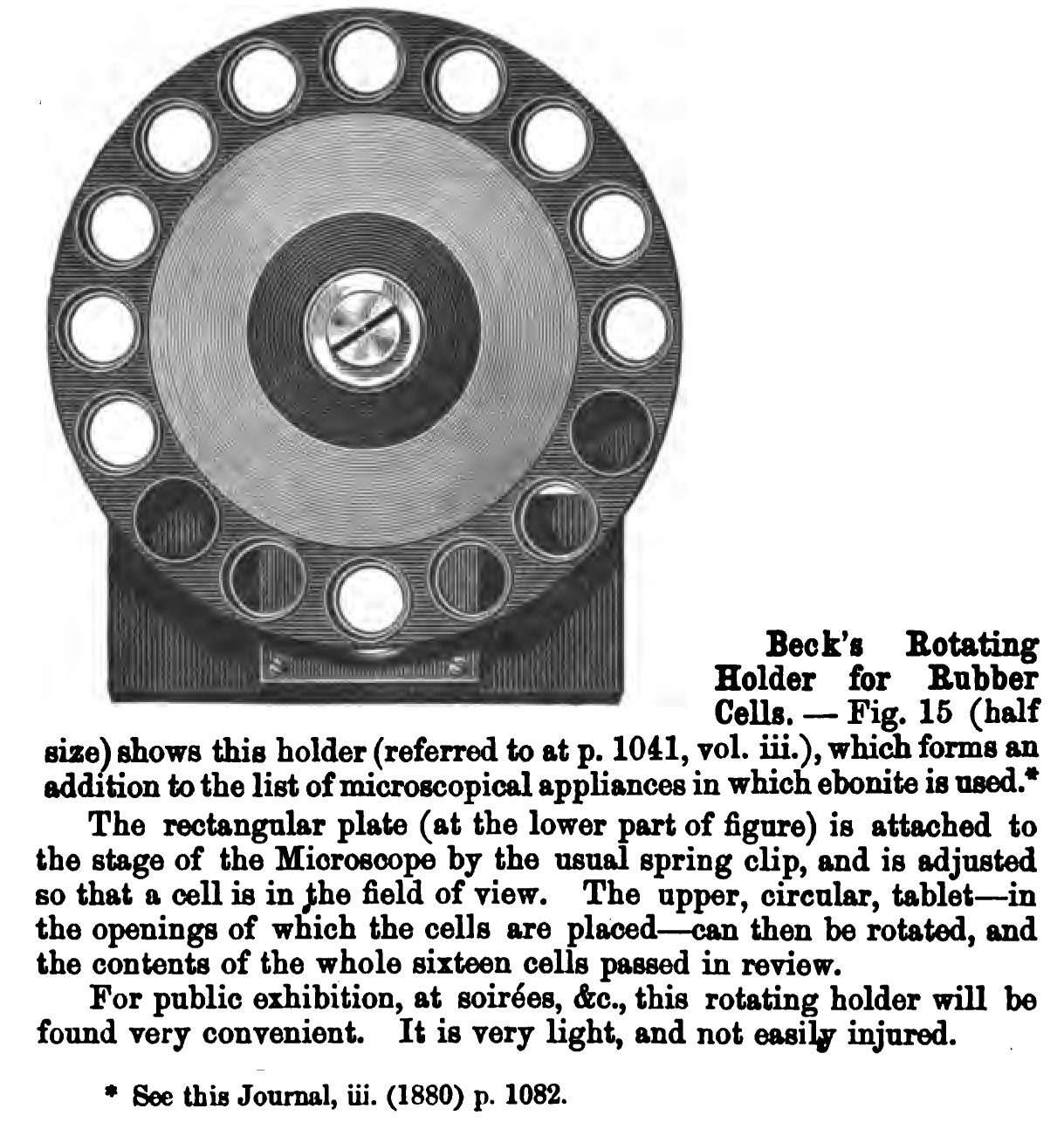
Figure 4. R. and J. Beck’s rotating cell holder, as exhibited by Charles Coppock to the Royal Microscopical Society in December, 1880.
Coppock’s split with R. and J. Beck occurred at the beginning of 1883. The January 1, 1883 issue of Hardwick’s Science-Gossip carried an announcement of the separation, and Coppock’s new shop at 100 New Bond Street (Figure 5).

Figure 5. Announcement of Charles Coppock’s separation from R. and J. Beck, and the opening of his new shop. From the January 1, 1883 issue of Hardwick’s Science-Gossip.
In May of 1882, Coppock had attended the British Medical Association’s Jubilee, as a representative “of the firm of
Messrs. R. and J. Beck, Opticians.” He exhibited “a number of
microscopes, which served, at the same time, to shew the excellence of the
instruments, and some capital preparations of the Bacillus Anthracis, and the Bacillus (now Mycobacterium) Tuberculosis. These preparations were prepared
according to the method of Dr. Heneage Gibbes, published in the Lancet of 5th
ult., and very successful they were.” Slides and stains for visualizing M. tuberculosis and other bacteria were to be early items for sale by
Coppock’s new business (Figure 6). The March, 1883 issue of Microscopical News and Northern Microscopist gave detailed instructions from Coppock on
how to prepare sputum samples and use the dyes he was then marketing.
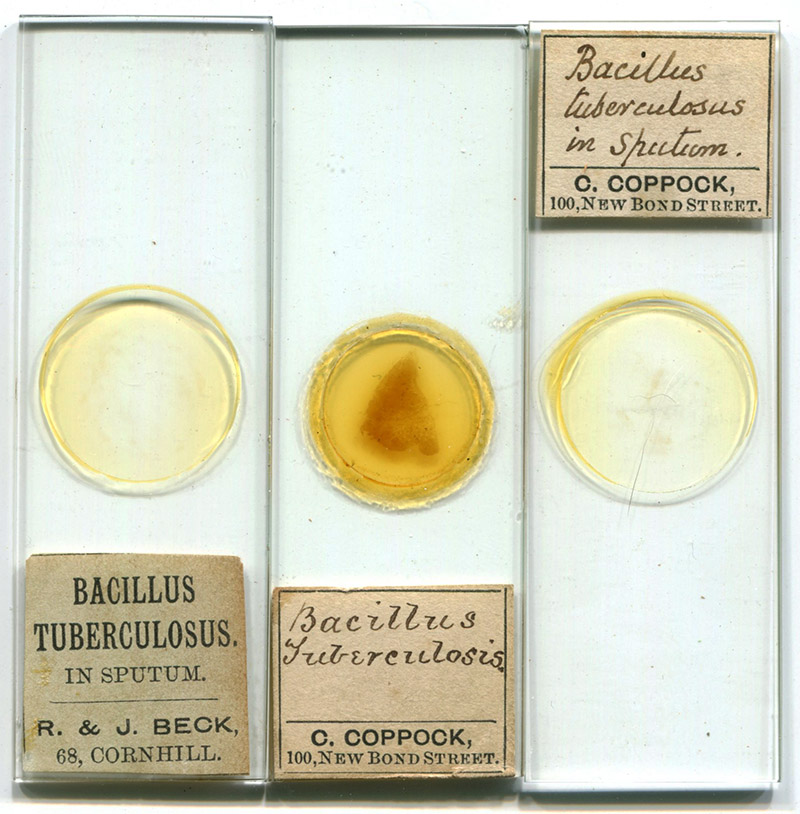
Figure 6. Microscope slides of the tuberculosis bacillus (Mycobacterium tuberculosis), retailed by R. and J. Beck and Charles Coppock. Coppock probably made these slides, or arranged for their production. He also sold dyes for preparation of these and other bacteriology preparations.
The same March, 1883 issue of Microscopical News and Northern Microscopist also announced “We are glad to note that Mr. Coppock, who
has for years been associated with the firm of Messrs. R. and J. Beck, has
opened magnificent premises at 100, Bond-street, London, where he will continue
his business as a manufacturing optician. The instruments and apparatus
manufactured by the firm (of which he was a member) will be supplied by him as
heretofore, together with all the most recent improvements of home and foreign
manufacture, and from his long experience and practical knowledge of the
requirements of the student and amateur we have no doubt that he will meet with
that support which his courtesy has hitherto awarded him. He promises us a full
catalogue with as little delay as possible, and our knowledge of his care and
ability assures us it will be well worth perusal when issued.”
Later that year, The
American Monthly Microscopical Journal announced that “Mr. Charles Coppock, who has recently established himself in an elegant
store in Bond Street, London, has issued his first catalogue of scientific
instruments, which is quite fully illustrated. Mr. Coppock does not intend to
confine his business to selling microscopes of any one make, but he proposes to
furnish any instruments that may be desired. We notice in the catalogue a list
of Tolles' microscopes and objectives, Bulloch's microscopes, and we understand
that Mr. Coppock has taken the agency for Spencer's objectives.”
The London Medical Record also announced “Mr. Coppock, of 100 New Bond Street, late a partner in the well-known
firm of R. and J. Beck, has published a very complete catalogue of instruments,
including microscopes, ophthalmic, meteorological, nautical, and surveying
instruments, &c., and their accessories. The pamphlet is profusely
illustrated, the engravings being exceedingly well executed. A considerable
space is devoted to microscopes, to which Mr. Coppock has given much attention.
Besides those sent out from his own factory, he incorporates in his catalogue
others of some of the most eminent foreign makers, including the names of
Prazmowski, Zeiss, Nachet, &c., and of the noted American firms, R. B.
Tolles and W. H. Bullock, for whom he is the English agent. It is impossible in
the limits of a short review to enumerate the many commendable instruments in
these classes ; but, in selecting the combination microscope for especial
remark, we do so from its combined advantages and moderate price. It has been
constructed, as the catalogue informs us, ' mainly from data obtained from
consultation with the leading teachers of science in Edinburgh,' and we
recommend all intending purchasers of microscopes to see this instrument before
arriving at a decision. All the accessories connected with microscopical study
are enumerated and priced, and in addition all the standard works bearing upon
the subject are set down in the catalogue and the cost given. Astronomical,
terrestrial, and naval telescopes, and transit instruments are next treated of,
and in close companionship are binocular field and tourists' glasses. The next
section embraces surveying instruments, and following them we are introduced to
nautical instruments, amongst which will be found some interesting examples of
compasses. Barometers occupy an important position, and are exhaustively
illustrated and described; thermometers (including clinical) being no less
prominent. Mr. Coppock next draws attention to anemometers, wind vanes, and air
meters; and the sunshine recorder, and sun-dial, originally invented in 1853,
by Mr. J. F. Campbell, of Niddy Lodge, Old Kensington, and which has proved a
most valuable adjunct to our list of scientific instruments, finds a place in
the catalogue and is copiously described. In the portion devoted to ophthalmic
appliances, Mr. Coppock again appears to advantage, having selected this
section of his avocation for especial study. The remaining portions of the
catalogue are devoted to the numerous if somewhat minor classes of instruments
that help to make up the professional appliances usually found at such an
establishment. In the August number of the Medical Record, we gave a lengthened
description of Mr. Cathcart's microtome, and it may be noted that every
instrument sent out from Mr. Coppock's establishment can be relied upon both
for quality and workmanship.”
The Journal of the Royal Microscopical Society described
Coppock’s Combination Microscope: “The general form of the instrument is
shown in [Figure 7], the stage and body being carried upon a turned pillar,
after the style of the Continental models, and the stage being as large as is
consistent with the relative proportions of the whole instrument. The body-tube
allows the highest objectives to be readily focussed by giving a slight spiral
movement to the tube, and the draw-tube is stopped when drawn out to the normal
nine inches. The side condenser is fixed by a revolving annulus to the body.
The revolving diaphragm plate is recessed into the stage. When the largest
aperture is used, the thread in the stage will allow of a fitting being screwed
into it to receive the various stage apparatus. For class demonstration it is
found that the hinged joint to the limb is not essential, and it is therefore
made in two forms, with and without joint” (Figure 7).

Figure 7.
Charles Coppock’s 1883 Combination Microscope. Coppock made this instrument both with and without a jointed limb. With the simple push-pull coarse focusing mechanism, this was probably a fairly inexpensive microscope to make and to buy. Left, engraving from the Journal of the Royal Microscopical Society (1883) series 2, vol. 3, page 265.
Right, a surviving example, adapted for nonprofit, educational purposes from http://stichtinghistorischemicroscopie.nl/microscopen/samengesteld-achromatisch-microscoop-sm-30.
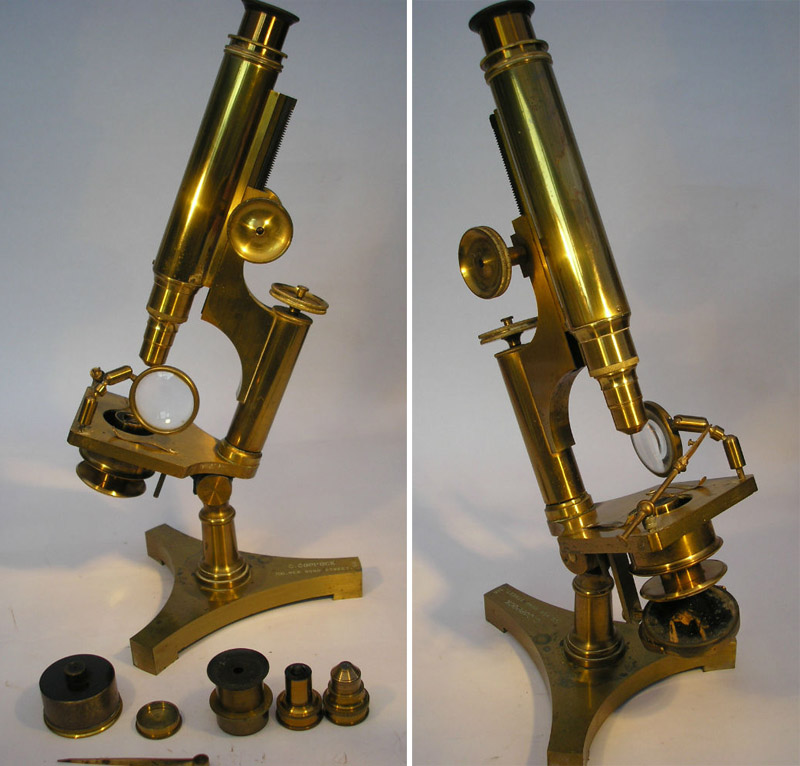
Figure 8.
A surviving Coppock microscope. It appears to be the same as the R. and J. Beck “Economical” model. Since Coppock was undoubtedly involved with development of Beck microscopes, it would be reasonable for him to continue manufacturing instruments along the same lines as his former company. Alternatively, he may have distributed microscopes built by Beck. Images from an internet auction site.
Coppock issued a variety of advertisements to support his new
venture in many magazines and books. Some examples are illustrated in Figure 9. Note the range of items he offered, and the many different
manufacturers whose products he retailed.
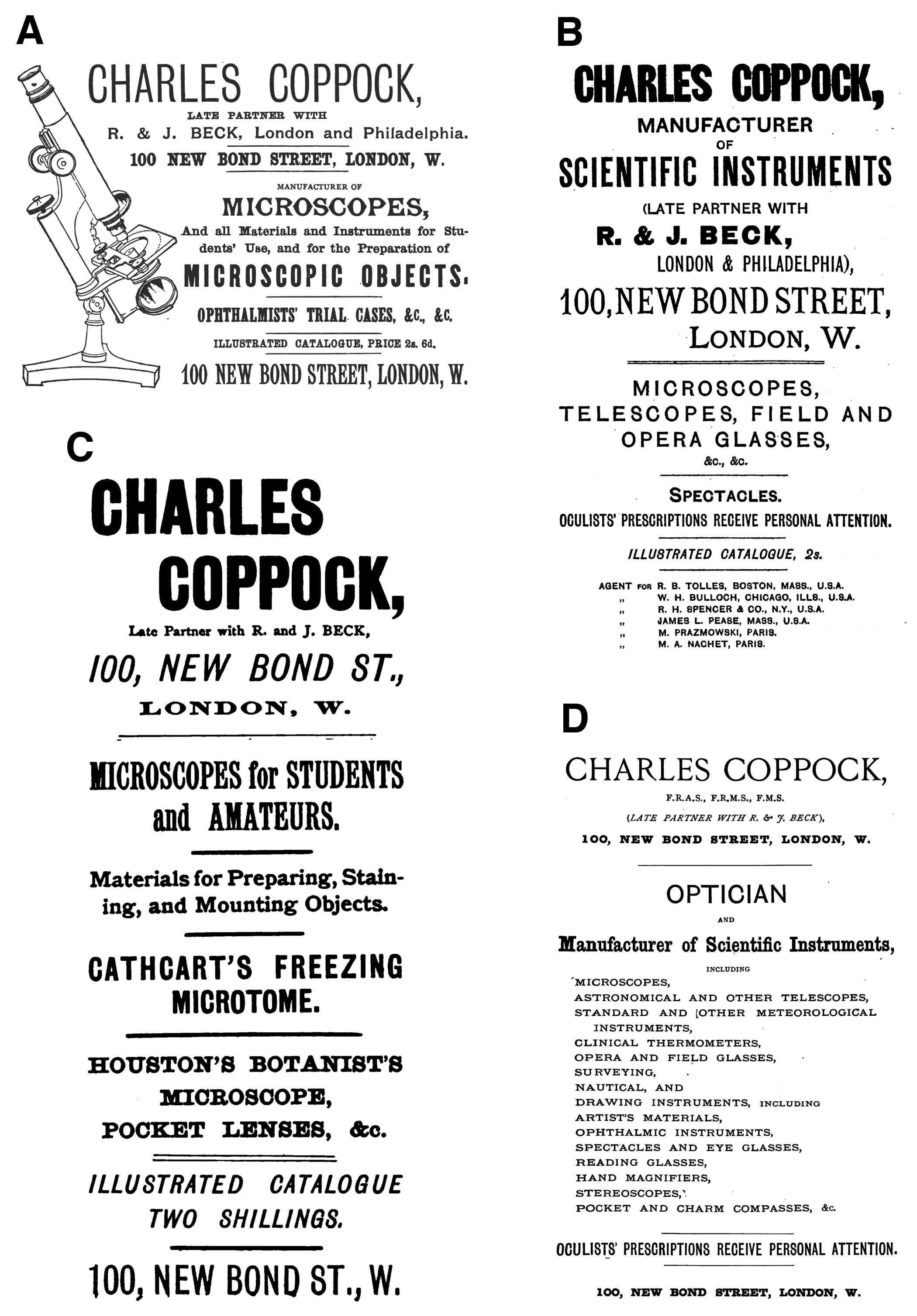
Figure 9.
Advertisements for Charles Coppock’s
microscopy business.
(A) The London Medical Record, Nov. 15, 1883. The microscope illustrated is the same as that shown in Figure 8, above.
(B)
Journal of the Royal Microscopical Society, 1883.
(C) Studies in
Microscopical Sciences, Vol. 1, by Arthur C. Cole, 1883.
(D)
A Catalogue of Modern Works on Science and Technology, 12th edition,
by George Christopher T. Bartley, 1883.
Coppock’s business appears to have been successful. The 1887 list of Fellows of the R.A.S.
lists Coppock’s’ addresses as both his business at 100 New Bond St., and his
residence at 109 Grosvenor Rd., Highbury New Park. At the time of the 1891 census, he was recorded as being an
optician and an employer of workers. He still lived at 109 Grosvenor Rd., Islington, along with two of his
children, an unmarried sister and two servants. The 1891, 1895 and 1899 Post Office Directories for London
and the 1899 list of Fellows of the R.A.S. list Coppock’s business as being
located at 26 Maddox St, W, just around the corner from his earlier New Bond
St. address.
Charles Coppock died 5 September, 1900. He remained a Fellow of the Royal
Microscopical Society, the Royal Astronomical Society and the Royal
Meteorological Society until his death. The Royal Meteorological Society noted in an obituary that “Mr. Coppock was one of those who study
science as a recreation. The microscope was his favourite instrument, both from
a mechanical and a scientific point of view.”
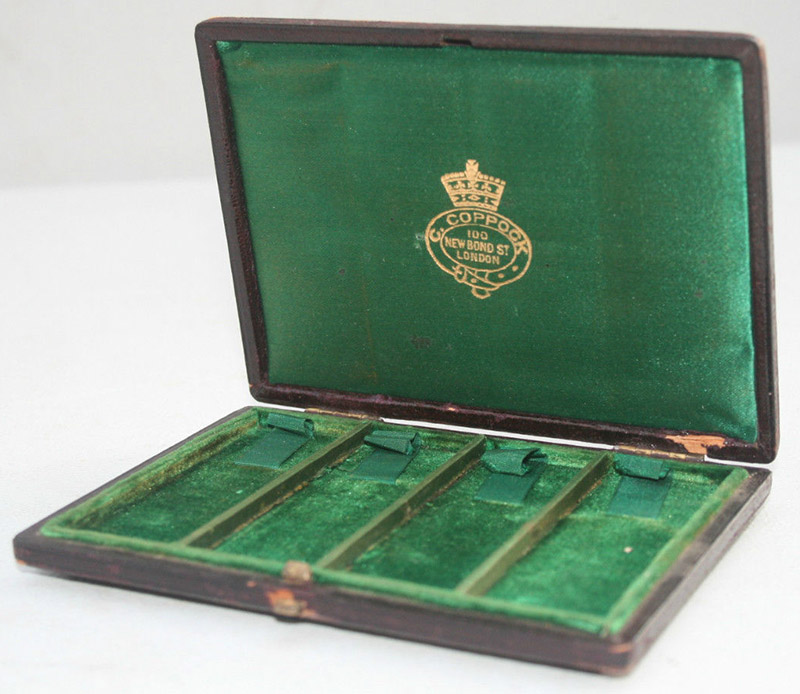
Figure 10.
A pocket-sized case for carrying microscope slides, retailed by Coppock.
Acknowledgments
Additional information on Charles Coppock’s microscopes and
other instruments will be greatly appreciated. Many thanks to Brian Davidson and Allan Winsser for their
insightful comments, and to the colleagues who have shared images of their
slide collections.
Resources
The American Monthly
Microscopical Journal (1883) Notes, vol. 4, page 139
Bartley, George C.T. (1883)A Catalogue of Modern Works on Science and Technology, 12th
edition. Chapman and Hall, London, page 3
Beale, Lionel Smith (1880) How
to Work With the Microscope, 5th edition, Harrison, London,
Appendix at rear of book, unnumbered page
Beck, Joseph, Robert Kemp, and Charles Coppock (1876) An Illustrated Description of the Economic
Microscope, Manufactured by R. and J. Beck
Boase, Frederick (1906) Beck, Joseph, in Modern English Biography, vol. 4, page 331, Netherton and Worth, Truro
Bracegirdle, Brian (1998) Microscopical
Mounts and Mounters, Quekett Microscopical Club, London
Burlingham, Lynn (2006) Keeping it in the Family, published
on-line at http://www.sole.org.uk/keepingit.htm
Cole, Arthur C. (1883) Studies
in Microscopical Sciences, Vol. 1, Bailliere, Tindall and Cox, London, page
iv
England vital statistics, accessed through ancestry.co.uk
Gill, Steven (2008) The Adye Enigma, Quekett Journal of Microscopy, vol. 40, pages 685-694
Glaisher, James (1867) The President’s Address for the year
1866-1867, Quarterly Journal of
Microscopical Science, vol. 7, pages 25-38
Hardwicke’s Science-Gossip (1883) Advertisement for Charles Coppock’s new business, Vol. 19, page v
Hardwicke’s Science-Gossip (1884) Note from Arthur J. Doherty, Vol. 20, page 185
International Health Exhibition, London, Catalogue of Exhibits in the Biological Laboratory (1884) vol. 10, page 402
Journal of the Royal
Microscopical Society (1880) Proceedings of the Society, series 2, vol. 1:,
page151
Journal of the Royal
Microscopical Society (1881) Proceedings of the Society, series 2, vol. 1,
page 172
Journal of the Royal
Microscopical Society (1883) Summary of Current Researches relating to
Zoology and Botany, Microscopy, &c., series 2, vol. 3, pages 265-266
The Lancet (1863) "Notice: Smith, Beck, and Beck, Manufacturers of MICROSCOPES, TELESCOPES, STEREOSCOPES, and other OPTICAL and SCIENTIFIC INSTRUMENTS, have REMOVED from 8, Coleman-street, to 31, CORNHILL, E.C. Our customers will find these new premises very superior in size, convenience, and position to those we have just left". General Advertiser, vol. 1, June 6
List of Members of the
British Meteorological Society, 1864, page 3.
Dated June 15, 1864, this list identifies Charles Coppock’s
address at the time as being 31 Cornhill, E.C.
The London Medical
Record (1883) New Inventions: Illustrated Catalogue of Scientific
Instruments by Charles Coppock, F.R.A.S., &c., Sept. 15, vol. 11, pages
399-400
The London Medical
Record (1883) Advertisement for Charles Coppock, Nov. 15, vol. 11, page iii
Microscopical News and
Northern Microscopist (1883) vol. 3, pages 89 and 121-122
The Midland Medical
Miscellany and Provincial Medical Journal (1882) The British Medical
Association’s Jubilee, vol. 1, pages 145-146
Monthly Notices of the
Royal Astronomical Society (1871) Notice regarding election of new Fellows,
vol. 31, page 177
Monthly Notices of the
Royal Astronomical Society (1887) List of Fellows of the Royal Astronomical
Society, June 1887, vol. 47, page 5
Monthly Notices of the
Royal Astronomical Society (1899) List of Fellows of the Royal Astronomical
Society, June 1899, vol. 59, page 8
Nature (1884) Review
of “Studies in Micrographic Petrography”
by Ady and Hensoldt, Jan. 24, vol. 29, page 283
Nuttall, Robert (2009) Notes upon an Excursion to the Pyrenees:
William Smith’s Last Collection of Diatom Slides. Quekett Journal of Microscopy, vol. 41, pages 45-52
Post Office London
Directory for 1895, part 4: Trades and Professional Directory, page 2014
Post Office London
Directory for 1899, part 3: Commercial and Professional Directory, page
1022
Post Office London
Trades Directory for 1891, page 1928
Quarterly Journal of the
Royal Meteorological Society (1900) Obituary Notices, vol. 26, page 214
Quarterly Journal of
Microscopical Science (1867) Proceedings of Societies: Royal Microscopical
Society, October 9th, 1867, new series vol. 8, page 57
Quarterly Journal of Microscopical Science (1867) Proceedings of Societies: Royal Microscopical Society, November 13th, 1867, new series vol. 8, page 59
The Queens University Calendar, 1859, Alexander and Sons, Dublin, page 60
Shephard, Mark (2003) The Beck Microscope Family. Quekett Journal of Microscopy, vol. 39, pages 577-594
Stevenson, Brian, and Steve Gill (2013) The many lives of Heinrich Hensoldt (1856 – circa 1918), Moritz Hensoldt’s errant son, Quekett Journal of
Microscopy, Vol. 42, pages 3-17.
Wise, F.C. (1958) William Smith, 1808-1857: a great diatomist. Quekett Journal of Microscopy, series 5, vol. 5, pages 41-43









